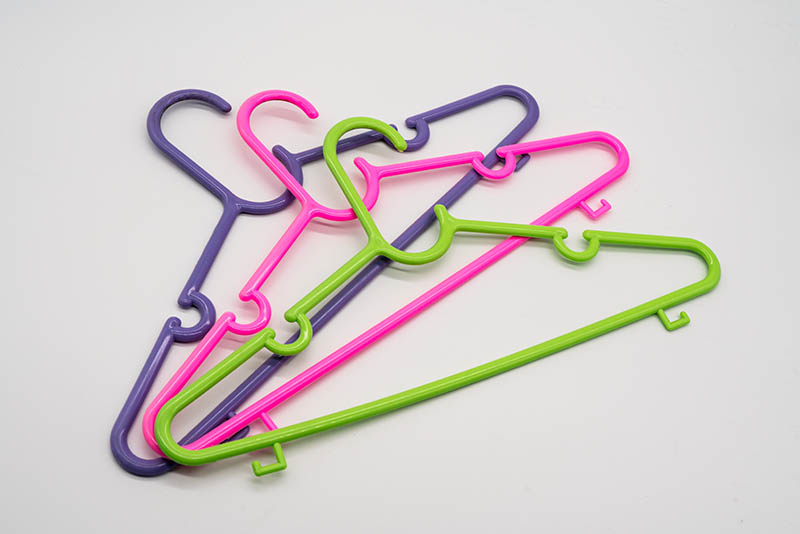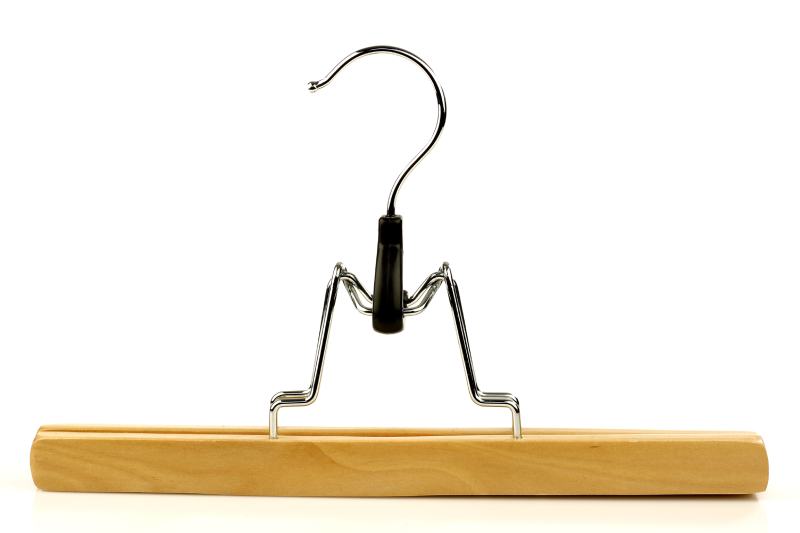9 Expert Tips on How to Hang Pants on a Hanger (4 Main Ways)
-
Kristin Hitchcock
- Last updated:

Hanging your pants in your closet can help you save valuable drawer room. Pants can be relatively thick when folded so hanging is a necessary space-saver for many. However, while hanging pants may seem easy, it can be surprisingly complicated. Pants can slip off the hangers or become tangled up together.
Occasionally, pants may even break weaker hangers.
Below, we’ve explained how to hang jeans and other pants as effectively as possible. There will be some small differences depending on your hanger, but we’ll look at those, too.
Using a Regular Hanger

Most people have simple, regular hangers lying around, so that’s what we’ll start with. Hanging pants on these hangers isn’t difficult, though you will need to fold them in a way to ensure they stay on the hanger.
The “standard hanger” we’re discussing is the triangular-shaped hanger with two diagonal bars and a horizontal one on the bottom. This hanger works perfectly fine for many uses. However, your pants may slip off one side.
1. Add Velvet or Hot Glue
To keep the pants from falling off, it helps to give them something to hold onto. Creating some friction makes the pants stay on much better. You can use velvet, hot glue, or moleskin. Place it on top of the horizontal bar, where the pants will sit. If you’re using hot glue, add a line going all the way across.
Adhesive moleskin is very easy to use and recommended. However, if you don’t have any lying around, you can glue velvet to the hanger or just add hot glue.
2. Fold the pants properly
You’ll want to fold the pants in half when hanging them on your average hanger. Fold them in half with pockets on the inside. The seat of the pants should be facing the outside. This gives the pants some heft and makes them less likely to slip around.
Drape the pants over the horizontal bar as evenly as possible. Adjust the pants so that they balance as well as possible. The previous tip will help with this.
3. Use Clothespins
If your pants keep slipping, attach them to the hanger using clothespins. Just use one or two to “hook” the pants in place.
 Using a Hanger with Clips
Using a Hanger with Clips

Hangers with clips were made for hanging pants. Therefore, they often work the best for the job. You can also make these hangers by adding clips to your regular hangers. However, with the world of online shopping, you should be able to find some of these online.
1. Fold Your Pants if Necessary
You don’t want the pants hanging out much further than the hanger. If your pants are wider than the hanger, consider folding them. If you don’t have much vertical space, you can also fold your pants in half to make them shorter.
Simply put, fold your pants as needed to make them fit as well as possible.
2. Some Clips are Adjustable
Many clips are adjustable to make hanging the pants easier. Mess around with your hangers to find out if this is the case. If they are, consider adjusting them as necessary.
3. Use Index Cards
On pants with sensitive fabric, you can use index cards to help protect them from the clips. Fold the card around the top of the pants where the clip goes. Then, attach the clip over the card. This will prevent the teeth or grooves from leaving a mark on the pants. You may need to use multiple cards if the teeth are particularly troublesome.
Furthermore, you can also use playing cards, cardstock, or similar materials.
 Using Clamping Hangers
Using Clamping Hangers

These hangers are made for pants and are often utilized when hanging suit pants. You can find them online, though they can be a bit expensive. They are often made of wood—instead of the usual plastic.
1. Fold Your Pants in Half
You’ll find that these hangers work best when you fold the pants in half. The hand pockets should be on the inside of the fold, while the seat is on the outside.
2. Hang Upside Down
These hangers are made to hold pants upside down. Therefore, when clamping, you’ll need to place the leg opening between the two pieces of wood. The buttons and zippers can get in the way if you try to hang the pants from the waistband.
One Last Tip: The Savile Row Fold
If you’re tired of your pants falling off the hanger, try the Savile row fold. This fold differs from the “usual” way to fold pants. However, it makes them stay in the hangar much better.
- Hang up a standard hangar.
- Hold the pants upside down by the legs.
- Place one leg on each side of the hanger as it is hanging. The horizontal bar should be between the cuffs of the pants.
- Drape one leg over the horizontal hanger, pulling it through so that it drapes down to the crouch of the pants.
- Drape the other leg over the first one. Again, tug it down, so it touches the pants’ crouch. The pants should be evenly hung at this point.
Now, the pants shouldn’t slip off the hanger no matter how much you shake them.
Conclusion
Hanging pants is fairly straightforward but several tips can make the process much easier. Using different folds can be helpful, for instance. Hanging pants is also completely different depending on the exact hanger you’re using so you’ll need to adjust your plan depending on what you have available.
Hopefully, our tips made laundry day a bit easier for you. Now, you can hang your pants up without them falling off and save room in your drawers. If you have standard hangers lying around, the Savile row fold is an easy way to keep the pants from slipping off.
If you’re serious about hanging pants, you may want to purchase a few hangers specifically made for this job. However, you can also use your standard clothing hangers.
Featured Image Credit: BBiDDac, Unsplash
Contents

 Using a Hanger with Clips
Using a Hanger with Clips